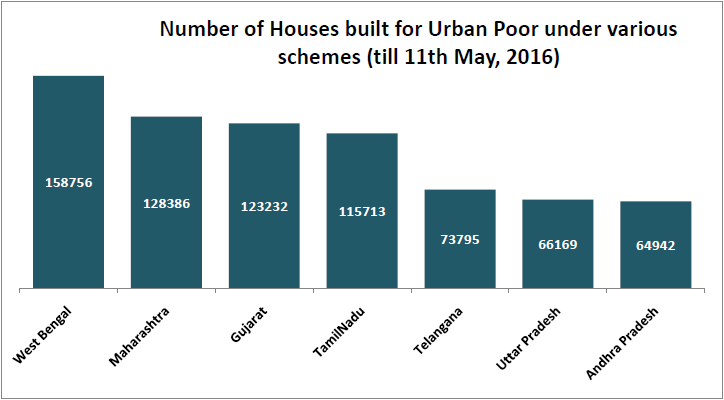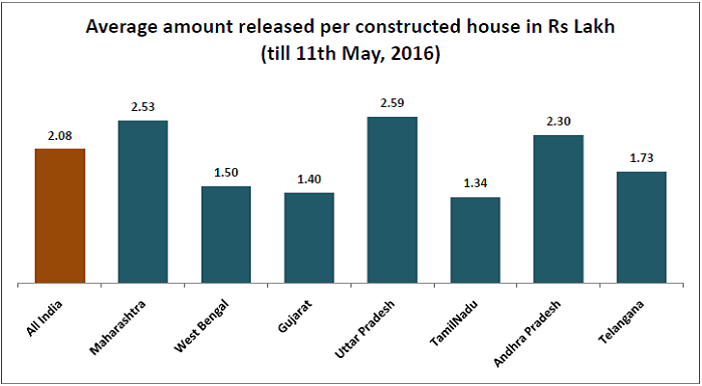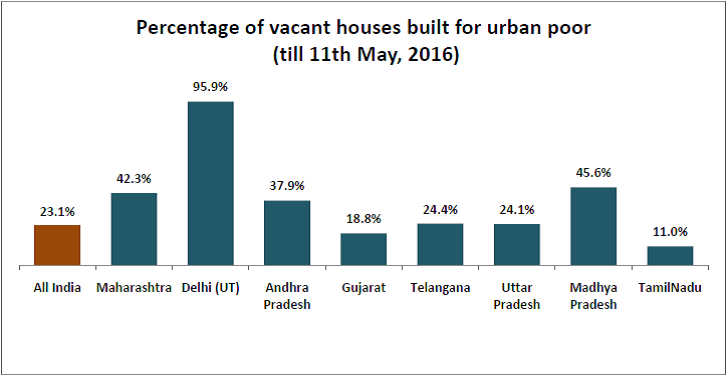[orc]Government data indicates that more than 10 lakh houses were built for the urban poor in the last 11 years and 23% of them are lying vacant. In Delhi, 96% of the completed houses are vacant.
Since the mid 2000s, urban housing has been a key priority area for various governments. In the last 11 years, three different schemes of housing for the urban poor have been implemented. As per the latest available government data, 23% of the more than 10 lakh houses built for the urban poor since 2005 lie vacant due to varied reasons.
Three different housing schemes for urban poor
Starting 2005, the Ministry of Urban Development, Government of India has been implementing three different housing schemes for the urban poor.
- The Jawaharlal Nehru National Urban Renewal Mission (JNNURM) was launched in 2005 and was initially planned for a seven year period (2005-2012). It has now been extended up to 31st March, 2017 for completing ongoing projects sanctioned up to March 31st, 2012.
- Rajiv Awas Yojana (RAY) was started in 2011 and has been discontinued in May 2015. The pending liabilities under this scheme have been subsumed in the new PMAY scheme.
- Pradhan Mantri Awas Yojana-Housing for All (PMAY-HFA – Urban) scheme for extending central assistance to States/UTs for providing houses and related civic amenities to urban poor including slum dwellers. This is launched in June 2015.
All the above schemes provide central assistance to States/UTs to build houses and related civic amenities to the urban poor.
More than 10 lakh houses built so far
There are no state level targets for these schemes and central assistance is sanctioned based on proposals submitted by states. Till date, a total of 10,32,443 houses sanctioned under the above schemes have been completed. Majority of these houses were sanctioned under JNNURM. More than 10 lakh houses have been completed under the JNNURM scheme while only 20954 houses are completed under the RAY scheme. The PMAY scheme is relatively new and only 710 houses have been completed till date.
Seven states account for more than 70% of the houses built
Out of the 10 lakh odd houses built under the scheme so far, more than 70% of the houses were built in the seven states of West Bengal, Maharashtra, Gujarat, Tamil Nadu, Telangana, Uttar Pradesh and Andhra Pradesh. The maximum numbers of houses were built in West Bengal followed by Maharashtra, Gujarat and Tamil Nadu. These are the only four states where more than a lakh houses were built. 23 States/UTs account for less than 10% of the houses built under these schemes.
An average of 2.08 lakh released per house
Till date, a total amount of Rs 21481.62 crore has been released to States/UTs under the three schemes for construction of houses. When compared with the number of houses constructed, the average expenditure per house comes to 2.08 lakh. Surprisingly, the average expenditure per house was different in different states based on funds released by the central government. In Uttar Pradesh, it was 2.59 lakh per house while the lowest was in Tamil Nadu (1.34 lakh per house).
96% of the houses built in Delhi lie vacant
Of the 10 lakh odd houses completed so far, 2,38,448 houses are lying unoccupied (vacant). In other words 23.1% of the houses completed so far are vacant. In Delhi, a staggering 95.9% houses are lying vacant. Of the states with a very high number of houses built for the urban poor, 42.3% are lying vacant in Maharashtra, 11% in Tamil Nadu, 18.8% in Gujarat, 37.9% in Andhra Pradesh, 24.4% in Telangana and 24.1% in Uttar Pradesh. Though highest number of houses was built in West Bengal, less than 1% (0.8%) are lying vacant there.
Who is to blame?
The Government of India (GOI) maintains that the construction and allotment of houses under these schemes is the responsibility of the State/UT Governments concerned. The reasons cited for the high percentage of vacancy are the following
- Reluctance of slum dwellers / beneficiaries to shift in cases of relocation projects
- Lack of / incomplete basic infrastructure and livelihood sources etc
GOI also says that it has been reviewing the issue of vacancy in the meetings of Central Sanctioning and Monitoring Committee (CSMC) and that it is advising the State/UT Governments to expedite allotment of vacant houses to the beneficiaries and submit plan for 100% occupancy. But nothing explains the vacancies in UTs where the central government itself is responsible.
Featured Image: Ministry of Housing and Urban Poverty Alleviation







3 Comments
There should be an inbuilt system in agreements in future, that state govt can auction the house, if it remains unoccupied within 6 months from the date of handing over. Further this is one side of the coin, as who financed the remaining part and stake of PSU banks is not known. When the Govt learns learns from past mistakes ?
Pingback: Oolta.in | 96% Of The Houses Constructed For The Urban Poor Are Vacant In Delhi
The inflation, rather the cost of living / goods is vastly different. Can you please give the data on inflation in different states and then the cost of construction in different states.